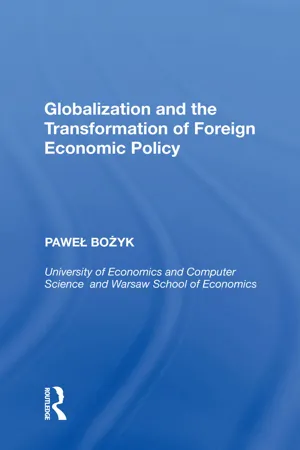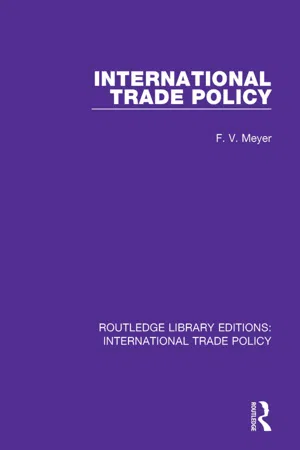Economics
Instruments of Trade Policy
Instruments of trade policy refer to the tools and mechanisms used by governments to regulate international trade. These instruments include tariffs, quotas, subsidies, and trade agreements. Tariffs are taxes on imported goods, quotas limit the quantity of imports, subsidies support domestic industries, and trade agreements establish terms for trade between countries. These instruments are employed to protect domestic industries, regulate trade flows, and promote economic interests.
Written by Perlego with AI-assistance
Related key terms
3 Key excerpts on "Instruments of Trade Policy"
- eBook - ePub
The Development of China's Information Resource Industry
Policy and Instrument
- Huiling Feng, Guojun Zhao, Minghui Qian(Authors)
- 2020(Publication Date)
- Routledge(Publisher)
3Economic instruments refer to the granting or deprivation of material resources (whether in the form of material or money). Economic tools make it cheaper or more expensive in terms of money, time, effort, and other valuables to pursue certain actions. Information instruments refer to “moral suasion” or persuasion and cover the transfer of knowledge, moral suasion, exhortation, and other persuasive actions.6.2 Common policy instruments for the information resource industry
IRI policy instruments are mechanisms for the state to adjust and normalize IRI activities in order to achieve IRI development goals. After evaluating relevant theories of industrial policies and policy instruments, as well as the features of the IRI, we classify IRI policy instruments into the following types.6.2.1 Organizational instruments
For organizational instruments, the government relies on its own power to solve policy problems directly. As the main organization in society, the government enjoys an unrivaled edge over private organizations in terms of scale, economic strength, manpower, power, and morality. In many policy areas, the government can always resort to its own force to solve problems directly.The main forms of organizational instruments include:- Government agencies. Government agencies directly complete many national affairs such as diplomacy and military actions, as well as domestic social affairs.
- National plans. They include various types of strategies, planning, plans, and action plans. There are mandatory or guiding programs.
- Public institutions and enterprises. Public institutions and enterprises in a country are often founded, managed, and supported by the government, and they are actually part of the public sector in a broader sense. In China, IRI policies (such as infrastructure, technology, industrial management, and other policies) are mostly executed by public institutions.
- Pawel Bozyk(Author)
- 2019(Publication Date)
- Routledge(Publisher)
Para-Tariff Instruments 4.3.1. The Concept of Para-Tariff Instruments The concept of para-tariff instruments of foreign economic policy refers to restrictions on foreign trade which are not customs duties but produce the same effects as customs duties. These are, thus, 'nearly' tariff instruments, starting the same or similar mechanism as the customs duty mechanism. Subventions are the only exception to this definition as they do not generate effects identical with those of customs duties and serve to stimulate exports rather than limit imports. Para-tariff instruments (with the exception ot subsidies) lead to the rise of the price of an imported product and reduce its competitiveness 011 the internal market of the importing country. 7 In this sense, para-tariff instruments can replace or complement customs duties. This is extremely useful given the fact that the importance of customs duties in foreign economic policy is marginal. Unlike customs duties, para-tariff instruments are not considered by international trade regulating institutions as complying with the market economy principles and, therefore, in this sense, are illegal. Nevertheless, in practice, they are often applied as being more effective and easier in comparison with customs duties. 8 Moreover, they are not universal in nature, which means that do not concern all participants in foreign trade. As selective instruments, they cover only certain economic subjects and selected goods. This causes them to be treated as discriminatory- eBook - ePub
- F.V. Meyer(Author)
- 2017(Publication Date)
- Routledge(Publisher)
6 INTRA-TRADE AND INTERNATIONAL TRADE POLICY1. Intra- and Inter-Trades under Free Trade
Internal protection means that foreign economic policy remains a domestic issue. Decided upon unilaterally, it is virtually non-negotiable. Effects on foreign countries are incidental. Those countries are not expected to complain as long as they are treated alike. Before 1934, this was the US attitude towards all protection. Tariff rates were set according to domestic requirements. The same attitude prevailed elsewhere. For instance, the UK decided unilaterally whether to be free trade or protectionist. Trade agreements softened these attitudes. Once trade barriers became negotiable, the various national foreign economic policies became intertwined. An international trade policy emerged. In place of domestic policies with international implications came the integration of the various domestic policies into an international one.Old attitudes lingered however. The change came only gradually. The preceding chapters have pointed to certain landmarks in the history of trade policy. Yet it is not possible to say precisely when international considerations were given sufficient weight relative to domestic ones, to justify the term ‘international trade policy’. But it can be said that the change has taken place in industrial products and has not taken place in temperate zone agricultural commodities. True there were some reductions on tariff rates on some agricultural commodities. But these were virtually meaningless where national authorities continued to intervene in quantities and prices. To this day, US agricultural legislation has priority over trade agreements legislation. Quantities of relevant imports can still be unilaterally determined in order to ensure that imports do not frustrate domestic production plans. The EC tries to regulate agricultural production through intervention in prices. It wants no disturbance of such prices through outside influences. In different ways, both the US and the EC want production-led, rather than trade-led developments in their agriculture. So does Japan. GATT-style negotiations can lead to only limited results for such commodities.1
Learn about this page
Index pages curate the most relevant extracts from our library of academic textbooks. They’ve been created using an in-house natural language model (NLM), each adding context and meaning to key research topics.


